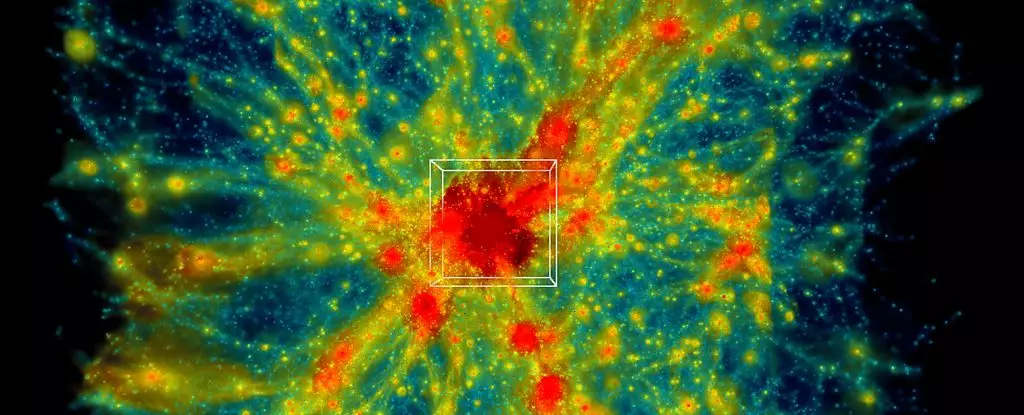In a monumental achievement, researchers at Oak Ridge National Laboratory (ORNL) have successfully executed the most expansive astrophysical simulation of the Universe to date. Dubbed ‘ExaSky’, this simulation utilizes the capabilities of the Frontier supercomputer, which harnesses 9,000 computing nodes to create a detailed representation of a section of the expanding Universe spanning over 31 billion cubic megaparsecs. This remarkable feat not only highlights advancements in computational astrophysics but also provides critical insights that could unravel the enigmatic characteristics of dark matter and the underlying physics of cosmic evolution.
At the core of the ExaSky project lies the necessity to simulate two contrasting components of the Universe: dark matter and conventional atomic matter. As articulated by physicist Salman Habib from Argonne National Laboratory, the understanding of the Universe’s behavior hinges on our grasp of both gravitational interactions of dark matter, which only engages through gravity, and the interactions involving atomic matter. This dual approach necessitates the integration of diverse elements, from the dynamics of hot gas to the lifecycle of stars, galaxies, and black holes, creating what Habib refers to as a comprehensive cosmological hydrodynamics simulation.
Employing such an inclusive methodology requires navigating the challenges of cosmic time scales. Unlike terrestrial events that we can observe in real-time, cosmic changes occur over vast periods—billions of years—that are far beyond human experience. Simulations offer a powerful tool for astrophysicists to conceptualize this cosmic evolution by adjusting parameters, accelerating time, and exploring cosmic phenomena with an omniscient lens. However, this process is far from trivial; the enormity of space and its intricate complexity necessitate advanced mathematical frameworks and exceptionally powerful computational resources.
Creating ExaSky has been an iterative process fraught with challenges. Initial simulations often sacrificed crucial variables for efficiency, limiting their scope. Habib points out that previously, simulating a substantial segment of the Universe, such as that observed by major telescopes like the Rubin Observatory, was feasible only within a gravity-driven approximation. The team faced the daunting task of refining algorithms, enhancing mathematical models, and developing the Hardware/Hybrid Accelerated Cosmology Code to ensure the success of this ambitious endeavor.
The role of the Frontier supercomputer proved to be pivotal. As the fastest supercomputer in the world at the time of the simulation, it facilitated the unprecedented task of modeling the complexities of cosmic expansion. While the volume represented in the current phase of ExaSky constitutes a mere 0.001 percent of the overall simulation, it holds promise for vast discoveries that could reshape our understanding of the Universe.
The advancements brought forth by the ExaSky simulation are not merely technical; they pave the way for significant breakthroughs in our comprehension of cosmic phenomena. The insights gleaned from such expansive simulations will assist astrophysicists in correlating their findings with observations drawn from modern survey telescopes, thereby bridging the gap between theoretical predictions and observable characteristics of the Cosmos.
As astrophysicists continue to parse the data generated by this monumental simulation, one can anticipate that the revelations concerning the nature of dark matter and the processes governing cosmic evolution will deepen. With further refinements and developments, ExaSky is poised to illuminate the details of the Universe’s origins, formation, and ultimate fate.
The achievement at Oak Ridge National Laboratory represents a significant milestone in the field of astrophysical simulations. With the ability to model such a vast volume of the Universe, scientists are preparing for groundbreaking revelations that could reshape our understanding of the cosmos and its fundamental components. As we stand on the brink of a new era in cosmological exploration, the future holds a wealth of possibilities that promise to deepen our comprehension of the Universe and our place within it. As researchers harness the power of computational advancements, they are not only expanding the frontier of astrophysics but are also unwittingly painting a more intricate picture of the very fabric of the Universe itself.

